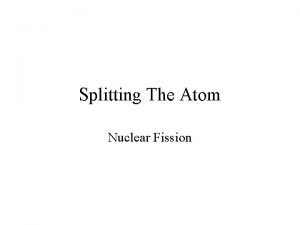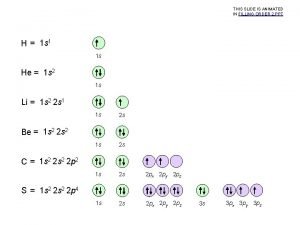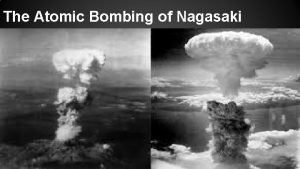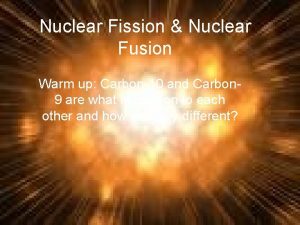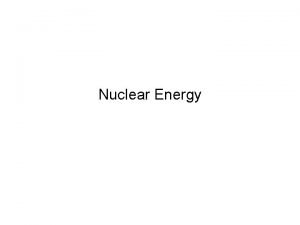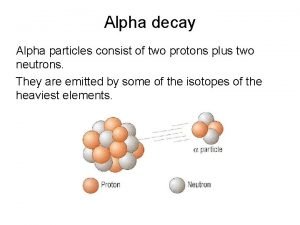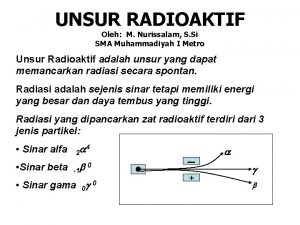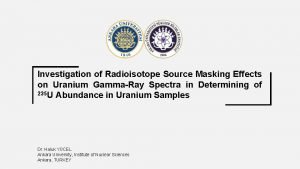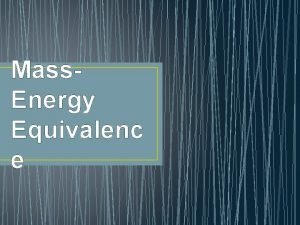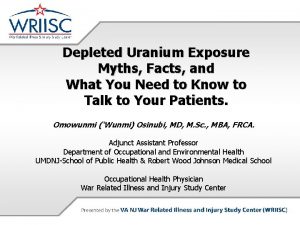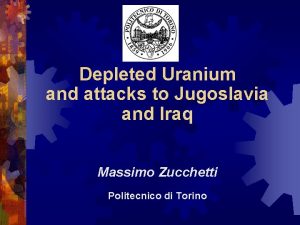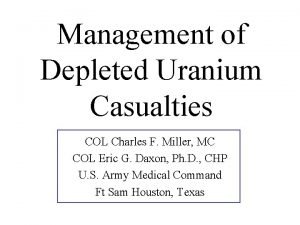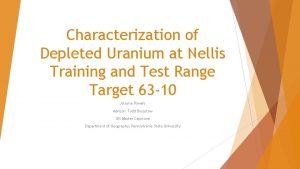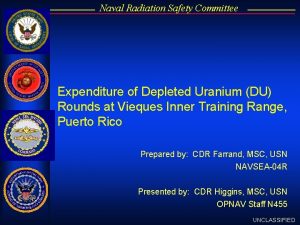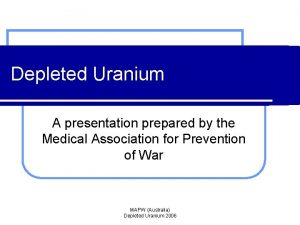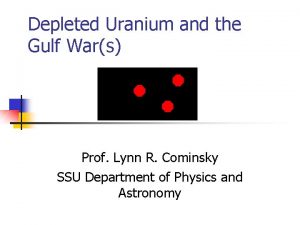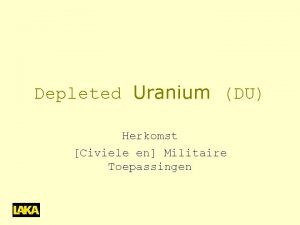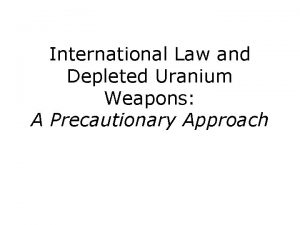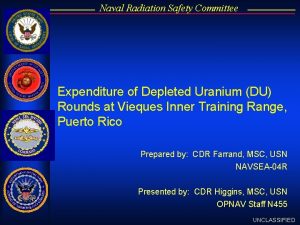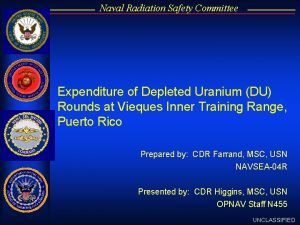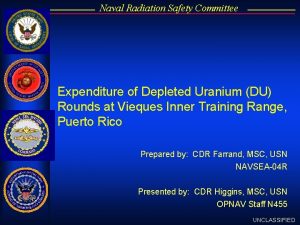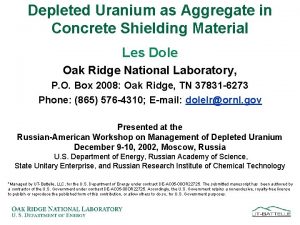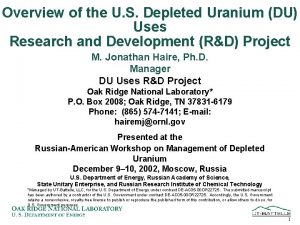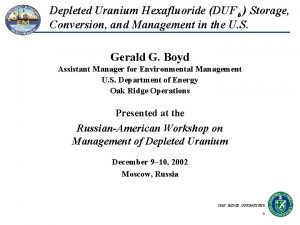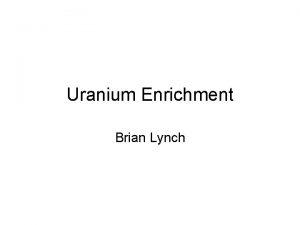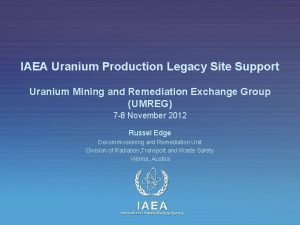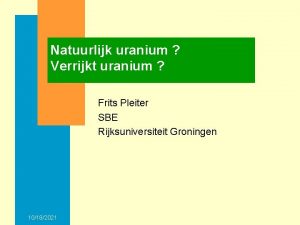Military Use of Depleted Uranium DU Potential Health




































- Slides: 36

Military Use of Depleted Uranium (DU): Potential Health Effects Werner Burkart Professor for Radiation Biology and Environmental Health based on a lecture by Burkart/Truckenbrod at an Int. Conference of Armed Forces Medical Services in Munich, January 1999 Thursday, January 11, 2001 Werner Burkart

Use of Depleted Uranium (DU) in ammunition • Gulf war: ~ 320 t • Kosovo conflict: ~ 10 t • Sarajevo safety zone: ~ 3 t DU is radioactive and chemo toxic • As a result of its use is there a risk of health effects? • Is there any evidence for these health effects ? Thursday, January 11, 2001 Werner Burkart 2

DU-Use in Kosovo (X Major Targets) Approx. 31, 000 rounds or 9 tons in more than 100 missions Thursday, January 11, 2001 Werner Burkart 3

Uranium in the Earth Crust: 0. 3 – 3. 0 g/t Natural Uranium consists of three radioactive isotopes U-235 and U-238 are the origin of two different decay chains U-234 is a product of the decay chain of U-238 Thursday, January 11, 2001 Werner Burkart 4

Feed, Product und Waste in a Process for Uranium Enrichment Feed Unat (0. 71% U-235) UF 6 Enrichment Process Waste: Depleted Uranium (DU) as Depleted UF 6 (0. 3% U-235) Enriched UF 6 (3. 6% U-235) Example: Pressurized Water Reactor Thursday, January 11, 2001 Werner Burkart 5

• DU is a waste product of uranium enrichment • Presently there are 570. 000 t of DU stocked in the USA – The stockage of DU in steel containers is expensive Ø DU is cheap and available in large quantities Thursday, January 11, 2001 Werner Burkart 6

Definition and Properties of Depleted Uranium (DU) • Content of U-235: 0. 2 – 0. 3 % • Low radioactivity • Practically pure -emitter and -radiation field through daughter products Heavy metal with high density: 18. 9 g/cm 3 • chemotoxic as most heavy metals • pyrophoric Thursday, January 11, 2001 Werner Burkart 7

Comparison between the Radiactivity of Unat and DU The activity of DU is 60% of that of Unat Thursday, January 11, 2001 Werner Burkart 8

Decay Chain of U-238 Nuclide U-238 Th-234 Pa-234 m U-234 Pb-206 Half-life Type of Decay 4. 5 * 109 years 24. 1 d 1. 17 min 2. 5 *105 a ( ) stable • DU contains 99. 8 % U-238 • U-238 is not in radioactive equilibrium with its daughter radionuclides • After few months equilibrium is reached between U 238, Th-234, Pa-234 m Thursday, January 11, 2001 Werner Burkart 9

Civilian Use of DU • • Colour Glazing (red and yellow) Steel alloys Catalysts Counterweights in fly wheels, fork lift trucks, keel lines of ships • Ballast in aircrafts (the first 550 Boing 747) • Shield material for -radiation (better than lead) Problem: Spontaneous ignition during the machining of the metal Thursday, January 11, 2001 Werner Burkart 10

Military Use of DU • Shielding in Tanks • Ammunition (first time in 1991, Gulf War, 320 t) The high velocity of DU ammunition permits to penetrate the reinforced armoring of tanks n On hitting the target DU ignites, forming an aerosol of DU particles and/or larger fragments n Aerosol: the particle size and the quantity depends on the impact angle , velocity and burning temperature n Alternative to DU = Tungsten Thursday, January 11, 2001 Werner Burkart 11

Anti Tank DU Ammunition Thursday, January 11, 2001 Werner Burkart 12

Anti Tank DU Ammunition Thursday, January 11, 2001 Werner Burkart 13

Target Hit by DU Ammunition Thursday, January 11, 2001 Werner Burkart 14

30 mm DU Rounds Found in Kosovo Thursday, January 11, 2001 Werner Burkart 15

Chemistry Uranium is present in all crystal and mantel rocks in trace amounts. The average abundance is 2 – 3 mg/kg. Uranium in the environment is dominated by U (IV) and U (VI) oxides: Anoxic: U (IV) (UO 2) insoluble, found in minerals (USi. O 4) Surface water, body fluids: typically U (VI) (UO 3 divalent cation UO 22+) Uranium used in penetrators and armor is in the zero oxidation state, which is thermodynamically unstable even at low temperatures. When exposed to the environment it will eventually oxidize (corrode). The oxidation liberates a large amount of heat. Thursday, January 11, 2001 Werner Burkart 16

Uranium metabolism Caveat: For more soluble uranium compounds intake is limited by consideration of chemical toxicity WHO limits for uranium intake: Drinking water: Tolerable Daily Intake (TDI) 2μg/L 0. 6μg/kg body weight Adsorption in the gut for dietary (monomeric) forms: even less for particulate and insoluble forms 2– 5% Most affected tissues: kidney; U binds to proteins (acute effects) bone surface (radiation dose) liver red bone marrow No enrichment in thyroid gland Thursday, January 11, 2001 Werner Burkart 17

Inhalation of different forms of uranium • Soluble forms cleared rapidly • Exotic (fired, “ceramic”? ) forms may remain in lung, tracheobronchial lymph nodes for years (Fisher 1988) Hot particles → New CRP Thursday, January 11, 2001 Werner Burkart 18

Aerosol characteristics A considerable fraction of the DU ammunition can become Aerosols Typical composition of an aerosol after hitting a solid target ca. 61 % U 3 O 8 Type S ca. 18 % UO 2 Type S ca. 20 % amorphous oxides Type F (Scripsick et al. 1984) 50 – 96 % of the aerosols can enter the lung AMAD < 10 m AMAD = Activity Median Aerodynamic Diameter Thursday, January 11, 2001 Werner Burkart 19

Contamination of Sites Dust/fine dust: loose contamination inside and outside military objects l Fragments in soil corroded DU is soluble Remediation: elimination of the fragments, clean -up of the contaminated zones Potential Radiation Dose rates External: -Radiation, Th-234, Pa-234 m Direct skin contact: 2 m. Sv/h -radiation in tanks: 0. 1 – 1. 3 Sv/h Internal: -Radiation (U-238), and l Thursday, January 11, 2001 Werner Burkart 20

Possible ways of incorporation Inhalation of dust particles of different size and solubility l Ingestion through food, water, swallowing of dust l Wound contamination l For military combat: shrapnel remaining in the body l Thursday, January 11, 2001 Werner Burkart 21

Uranium Metabolism The uranium compounds can be classified according to their solubility and consequent transportability from the respiratory organs into the body liquids (ICRP 66) Very slightly soluble ( S: low): Moderately soluble (M: medium): Easily soluble (F: fast): UO 2, U 3 O 8 UF 4, UO 3, UO 4 UF 6, UO 2(NO 3)2, UO 2 F 2, UO 2 SO 4 Uptake by the gastro-intestinal tract: f 1 = 0. 002: 0. 2 % -”- (Moderately and very slightly soluble) f 2 = 0. 02: 2. 0 % will transfer to blood (soluble) Thursday, January 11, 2001 Werner Burkart 22

Health consequences of the incorporation of DU Target organ Chemotoxicity Kidney Radiotoxicity Lung and bone Thursday, January 11, 2001 Werner Burkart 23

The lung as target organ l l l The lung is the primary organ at risk from inhalation of Type S uranium compounds The biological half-life of these compounds in the alveolar region of the lungs can be as long as 16 years Complete retention by lymph nods is assumed Particles in the upper region of the respiratory system move by mucociliary transport to the gastro-intestinal tract 0. 2 % is reabsorbed by the intestine and the rest is eliminated via feces Thursday, January 11, 2001 Werner Burkart 24

Kidney and bone as critical target organs for soluble uranium components Inhaled uranium (Type F) will rapidly transfer to blood l 98 % of ingested uranium (F) will be eliminated through the feces and 2% absorbed by the intestine For both types of uptake l U as a heavy metal, is chemotoxic for the kidney (limit: 3 g. U/g of kidney tissue, 0. 9 mg/both kidneys) l Bone is considered critical for accumulated radiation dose l Thursday, January 11, 2001 Werner Burkart 25

Model Predictions of the Uranium Content of Bone as a Function of Time after Injection into Blood for Different Ages Thursday, January 11, 2001 Werner Burkart 26

Annual limits for U-238 (Strl. Sch. V, 1989) Ingestion Inhalation f 1 = 0. 02 f 1 = 0. 002 6 * 102 3 * 105 3 * 106 50 25 * 103 250 * 103 Solubility F M S [Bq] 3 * 104 1 * 104 [mg] 2. 5 * 103 830 Thursday, January 11, 2001 Werner Burkart 27

Results of Animal Studies (dogs) The Solubility of the inhaled uranium compounds determines the target organ Compound Level of exposure Duration of study Body Concentration [mg U/kg] Organ Concentration [ g U/g] Cumulative dose Effect 16 Lung 2000 (6. 6 Gy) Lung tumors (4/13) UO 2 5. 8 mg 5 a UF 6 250 -270 mg/m 3 * 1 h < 1 a 0. 67 Kidney 1. 5 Reversible kidney damage UO 3 * x. H 2 O * y. NH 3 80 – 160 mg/m 3 * 1 h < 1 a 0. 058 Kidney 0. 6 -3. 5 Reversible kidney damage Thursday, January 11, 2001 Werner Burkart 28

Typical values Soil (U-238) 0. 3 – 11. 7 mg/kg UNSCAR 1993 Air (U-238) 2. 5 * 10 -8 – 10 -7 mg/m 3 NCRP 1999 Water (Unat) 3 *10 -2 – 2, 100 g/L surface water Drury et al. 1983 3 *10 -3 – 2, 000 g/L ground water Food (U-238) 0. 9 – 1. 5 g/d UNSCAR 1977 Urine (U-238) 8 * 10 -3 – 6 * 10 -2 g/24 d KWU 1999 Feces (U-238) 1. 7 – 3. 3 g/24 d KWU 1999 Thursday, January 11, 2001 Werner Burkart 29

Analytical Methods (detection limits) Urine (24 h): ICP-MS (n. Bq - Bq U-238) -Spectrometry (0. 5 m. Bq/d) Fluorimetry (13 m. Bq/L) Urine (spot): For 1 g Creatinine Feces (24 h): ICP-MS Hair: ICP-MS, treatment is necessary (long-term information) Nails: ICP-MS, treatment is necessary (long-term information) Lung counter In-vivo methods Detection limit: 100 -300 Bq of Unat Thursday, January 11, 2001 Werner Burkart 30

Studies on 33 Gulf-War veterans Cohort of US Soldiers wounded by DU or present in a vehicle hit by DU ammunition (friendly fire) • The study started 3 years after the war • Blood parameters: no significant alteration Uranium in urine 18 veterans with fragments [ g/g Crea. ] 15 veterans without fragments [ g/g Crea. ] 1993/94 4. 47 0. 03 1995 6. 40 0. 01 DU fragments in the body release uranium which shows up in urine (increased mobility of uranium with time) Thursday, January 11, 2001 Werner Burkart 31

Available Epidemiological Information There are no studies on populations exposed only to uranium l Uranium is only a minor contributor to naturally or artificially elevated radiation exposures Þ Indirect Risk Evaluation l n Experimental radiobiological information n Mechanistic considerations Thursday, January 11, 2001 Werner Burkart 32

In Search of a Definition of the Gulf War Syndrome I The 10 most frequently reported problems by Gulf War veterans (N = 52. 835) Tiredness 20. 5% Shortage of breath 7. 9% Skin rash 18. 4% Sleeping problems 5. 9 % Headache 18. 0% 4. 6% Muscle and joint pain 16. 8% Diarrhea and other disturbances of the gastro-intestinal tract Other symptoms 3. 6% Loss of memory and other symptoms 14. 0% Chest pain 3. 5% With no problems 12. 3% A Guide to Gulf War Veterans Health, 1998 Continuing Medical Education Program Thursday, January 11, 2001 Werner Burkart 33

In Search of a Definition of the Gulf War Syndrome II Distribution of diagnoses (N = 52. 835 veterans) No diagnosis 26. 5% Digestive system 11. 4% Musculosceletal and Connective tissues 25. 2% Nervous system 8. 3% Circulatory system 7. 1% Disturbance of the Psychological equilibrium 15. 1% Infectious diseases 7. 0% Respiratory system 14. 3% Injuries and poisoning 4. 7% Skin tissues 13. 5% Urogenital system 3. 4% Neoplasm 0. 4% A Guide to Gulf War Veterans Health, 1998 Continuing Medical Education Program Thursday, January 11, 2001 Werner Burkart 34

Other Agents Discussed in Connection with the Gulf War Syndrome l l l l Fire fumes, soot, various harmful chemicals Napalm Several toxins Vaccines Pesticides Insecticides Protective substances against chemical weapons Thursday, January 11, 2001 Werner Burkart 35

Summary No acute risk l Theoretical cancer risk due to DU contamination much smaller than that from natural radiation l Complications due to perception (emotional, psychological, stress-related) Þ Possible future actions: l Radio-ecological assessment, dose estimates n Health-effects assessment n Occupational hygiene: monitoring before/after deployment, documentation of DU activities, doses, health statistics n Thursday, January 11, 2001 Werner Burkart 36
 Use of uranium
Use of uranium Custom fabric solutions for military use
Custom fabric solutions for military use Flaccid cell
Flaccid cell Water potential and osmotic potential
Water potential and osmotic potential How to find ionization constant for water potential
How to find ionization constant for water potential Neuronal pool
Neuronal pool Nerve action potential
Nerve action potential Define graded potential
Define graded potential Action potential definition
Action potential definition Graded potential
Graded potential Osmotic potential vs water potential
Osmotic potential vs water potential Source of bioelectric potential
Source of bioelectric potential End-plate potential vs action potential
End-plate potential vs action potential Neuromuscular junction ach
Neuromuscular junction ach Action potential resting potential
Action potential resting potential Action potential resting potential
Action potential resting potential Sales potential vs market potential
Sales potential vs market potential Equipotential lines
Equipotential lines Electrical potential
Electrical potential Electric potential and potential difference
Electric potential and potential difference Joules per columb
Joules per columb Electric potential from electric field
Electric potential from electric field Pe q
Pe q Electrical potential
Electrical potential Orbital diagram for uranium
Orbital diagram for uranium Plutonium vs uranium bomb
Plutonium vs uranium bomb Are nuclear power plants fission or fusion
Are nuclear power plants fission or fusion Uranium 238 decay
Uranium 238 decay Periodic table electron affinity
Periodic table electron affinity Uranium-238 alpha decay
Uranium-238 alpha decay Uses of uranium
Uses of uranium Contoh isotop adalah
Contoh isotop adalah Masking uranium
Masking uranium Is uranium a main group element
Is uranium a main group element Uranium phosphate maroc
Uranium phosphate maroc Uranium ore
Uranium ore How does the mass-energy equation e= mc 2relate to fission?
How does the mass-energy equation e= mc 2relate to fission?
